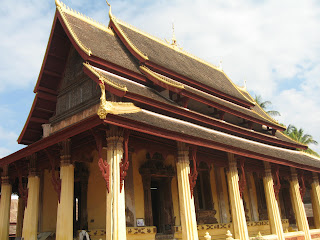Wednesday, February 13th, 2013 Vientiane
Last night we intended to go to a night market to find something to eat but we followed the Lonely Planet map instead of the tourist map, which was a mistake. We passed by some noise that sounded like a night market but was in the wrong place according to the map. Then we found 2 stalls in a parking lot at the right place and that didn't look very good so we wandered back through town to a restaurant that looked okay. Today, by looking at the tourist map, we realized our mistake. Anyway, we had a pretty good dinner for 100,000 ($12.50) kip total including a litre of draft beer. Not a complete loss.
We had passed by the Nam Phu fountain area near our hotel earlier in the day. It looked nice but nothing was happening. However, after dark a number of built-in restaurant and bar stalls open with seating all around the fountain and music and lights. We'll go there tomorrow night for Valentine's Day.
This morning we tried the hotel buffet breakfast (included). It was quite good. They make good omelettes and have a noodle soup station. Plus there are other hot dishes like "Beef Stomach Stew" which is surprisingly good. Looking out the hotel window, it's always amusing to see local people going to work in the morning wearing sweaters and jackets. It's a frigid 25C early in the morning. It is winter here too, I guess.
Our first stop was Wat Si Saket, a temple a few blocks from our hotel. There are thousands of Buddha statues all over the place, as usual - well over 2,000 Buddha images. This time the temple had many little shelves in the temple walls, each holding a couple of small Buddhas. Of all the Buddhas we've seen, only one looked like the chubby seated Buddha image that is the common perception in North America. Otherwise, Buddha looks quite fit.
While we were there, a young monk chatted with us a bit. Many young men become monks for several months or years. It's a tradition and also a way to become educated. ("Madonna Housers" Ernie Perrier calls them).
Lots of Buddhas in one of the side buildings. The Buddhas are wrapped in a sash which changes depending on the season.
The main temple.
The Presidential Palace is a beautiful building just down the street.
Next to it is Ho Phra Keo Museum, another temple that used to house the Emerald Buddha that we saw in the Royal Palace in Bangkok. Apparently the Emerald Buddha was given by the Sri Lankan king to the Laos king hundreds of years ago. Sometime in the 1700s, there was war in the land and the king of Siam (now Thailand) offered to keep the Emerald Buddha safe for his friend, the king of Laos. Well, somehow it's still there.
The former Emerald Buddha temple
Enter the Dragon.
A downtown street by the museum and presidential palace. There are quite a few trees in Vientiane.
Another random temple down the street. They're all over the place.
We walked to the COPE Physical Medicine Rehabilitation Centre to look through the Visitor Centre there. COPE provides physical rehabilitation and prosthetic devices to those who have lost limbs, mostly due to the cluster bombs that the Americans dropped on Laos. There were an estimated 260 million sub-munition "bombies" as they are called locally that were dropped on Laos between 1964 and 1973. At least 78 million failed to explode. The way it works is that a normal size bomb is dropped from an airplane. However, it contains hundreds of softball sized bombs which disperse over an area of about 2 football fields. This was all part of the "secret war" that the Americans conducted to disrupt North Vietnamese supply routes. A lot of Lao people were killed during the bombing but people are still being killed and maimed by contact with bombs that did not explode - UXO or "unexploded ordinance".
Rural Lao people are poor and scrap metal is valuable, so sometimes they take a chance and pick up pieces of bombs that they find in the forest. There are lots of them - on average, a bomb was dropped on Laos every 8 minutes for 9 years. Or sometimes, a family will have a cooking fire on the ground where there is no evidence of a bomb. The heat can detonate a bomb buried there, killing or maiming the whole family. Often the victims are children. COPE can bring a rural person to the clinic, give them physical rehabilitation and fit them with a custom made prosthetic device for an average of $200 each. This is a very good organization, meeting a need without any ideology other than a campaign to abolish cluster bombs.
A display of cluster bombs.
A display of a typical rural Laos home in which most metal items are made from bomb casings. Note the metal detector used to find scrap to sell. A risky business for desperately poor people.
A display of some home-made prosthetic devices, some made with steel from UXO. Sadly ironic. COPE has a website at www.copelaos.org.
By the time we left a donation at COPE and walked home, we were beat. We went back to JoMa cafe and split a footlong sub, then came back for a rest.
Tonight we have a reservation at a Lao cultural show and dinner. Should be fun.












No comments:
Post a Comment